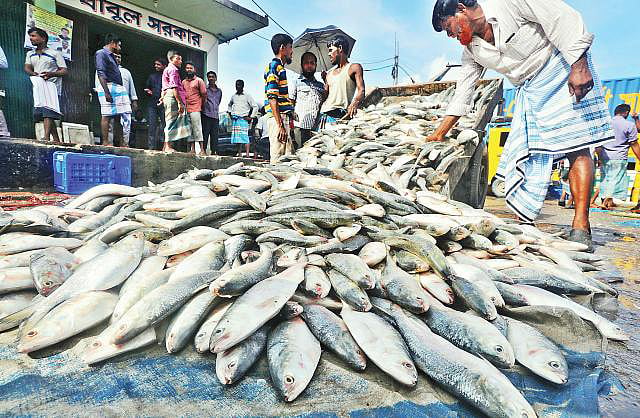Why hilsa appeared late this season

Three weeks had been passed since the authority lifted the 65-day ban on netting hilsa on 23 July, but the fishermen of Jorkhal in the coastal district Bhola, were still found frustrated with poor catching of the fish.
“Even in last year, we caught hilsa in the river. But this year seems different,” said Md Masud Rana, president of Jorkhal Fishermen Association.
The fishing community along the coastal belt prepared their trawlers after the ban was lifted. But they could not sail to the estuaries and deep sea because the sea remained rough for 10 days. Those who went fishing had returned with poor catches.
Barguna Trawler Owners Association president Golam Mostafa, echoing Masud, said, “All the trawlers sailed to the hilsa catchment points but returned empty handed.”
The dwindling production of hilsa has affected the fish markets in Dhaka and other districts.
A fish trader at Kawran Bazar, Abul Kashem, said price of hilsa was high due to shortage in supply. “The market of hilsa is not booming,” he regretted.
Shoppers too have shared their frustration over the price of hilsa. Imran Ahmed, a resident of Moghbazar, came to Kawran Bazar fish market on Friday. He looked displeased after buying a 900gm hilsa at Tk 1,300 per kilogram. “I don’t know whether I can buy any more hilsa this season like I did last year,” Imran said.
Usually, fishermen catch abundant hilsa after the yearly 65-day ban on netting hilsa is lifted. But the fishermen could not capitalise the prime time this year because of rough weather. Now, all the fishermen, suppliers and traders are looking forward to the upcoming full moon on 22 August, with a hope for a good catch.
“The year will end dull if we fail to catch enough hilsa during the next full moon,” fishermen organiser Masud said anxiously.
Fisheries experts, however, said that the fishermen will not need to worry as the season is not over yet and there is no evidence of change in hilsa migration route.
According to the experts, abundance of hilsa depends on the lunar cycle, water flow, brackishness of water, and rainfall.
Md Anisur Rahman, the chief scientific officer at Bangladesh Fisheries Research Institute Riverine Station Chandpur, said around full moon and new moon, hilsa become very active -- swimming, feeding and migrating with the tide.
Hilsa does not only appear in August. Fishermen will catch abundance of hilsa in the coming full moon and new moon until the hilsa spawning session in October, Anisur said.
The researcher predicted good luck for the fishermen, citing huge landing of hilsa at Fishery Ghat of Cox’s Bazar in the recent days.
A fish wholesaler at Fishery Ghat, Giasuddin Ahmed, told Prothom Alo on Friday that the selling price of hilsa started to fall as hilsa production increased. He expressed his hope about more hilsa in the coming days, particularly after the next full moon.
When the Cox’s Bazar fishermen are enjoying good catches of hilsa now, why is there shortage of hilsa across the Patuakhali, Barishal and Chandpur zones?
Anisur Rahman replied, giving a brief about characteristics of hilsa. “A shoal of hilsa swims at the same direction. Hilsa never stay long at a same place. Hilsa would migrate through the route along Mirserai, Noakhali, Hatia, Charfesson of Bhola and Patuakhali. This year, hilsa first appeared in Cox’s Bazar and not necessarily will come through the same route in the coming years. In the previous year, hilsa even came through the Patuakhali coast.”
Rainfall influenced the abundance of hilsa in Cox’s Bazar in the first phase, thinks Manmatha Nath Sarker, former national consultant at Bangladesh Marine Fisheries Capacity Building Project.
“More rainfalls reduce salinity in the coastal water and make hilsa migration easy. In this year, comparatively more rainfalls occurred over the Naf river and adjacent places. That’s why hilsa frequented much in the water there,” Manmatha said.
He added that downpours in the river Teesta as well as the Padma this year are making the river water brackish with rapid current. Brackish river water usually attracts the hilsa for spawning.
Due to increasing rainfalls and the river current, Patuakhali fishermen saw abundance of hilsa on Friday, he mentioned.
Anisur Rahman and Manmatha Nath Sarker, even though conveying good news for the fishermen, expressed their concerns about river water pollution and climate change.
Anisur said, once hilsa were found in the range between Chandpur and the Meghna Bridge at Ghorashal. But hilsa are not frequenting at the range due to river water pollution and sedimentation.
Department of fisheries’ hilsa section assistant director Masud Ara Mome thinks that the decreased appearance of hilsa in August is temporary. She said, “Fishermen have nothing to be impatient about. Abundance of hilsa has been landed in Cox’s Bazar. We hope the fishermen of other places will see good catches of hilsa soon.”
*This report is originally published in the print and online editions of Prothom Alo, has been rewritten in English by Sadiqur Rahman.